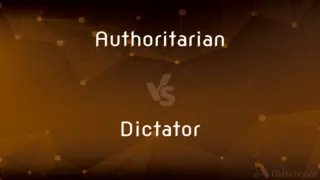Horizontal Integration vs. Vertical Integration — What's the Difference?
By Tayyaba Rehman — Published on November 27, 2023
Horizontal Integration involves a company expanding in its own industry, while Vertical Integration involves expanding into different stages of production within its industry’s supply chain.

Difference Between Horizontal Integration and Vertical Integration
Table of Contents
ADVERTISEMENT
Key Differences
Horizontal Integration refers to the process where a business grows by acquiring or merging with competitors in the same industry and operating level. Vertical Integration, conversely, concerns itself with a company’s expansion through the supply chain, either upwards or downwards, within its own industry.
The essence of Horizontal Integration is to dominate a particular market segment by acquiring similar companies. Vertical Integration aims to improve efficiency and control over the company's supply chain by either moving backwards into acquiring suppliers or forward into securing distributors.
Horizontal Integration often aims to boost the company's market share and eliminate competition by amalgamating similar businesses. On the other hand, Vertical Integration seeks to reduce costs, stabilize input prices, and ensure consistent supply by acquiring businesses at different production levels.
Through Horizontal Integration, businesses aim to grow in scale, thereby potentially reducing competition in the market. Vertical Integration permits companies to achieve better economies of scale by controlling different stages of production and distribution.
Comparison Chart
Direction
Same industry level expansion
Upward or downward supply chain expansion
ADVERTISEMENT
Primary Objective
Eliminate competition, increase market share
Control over supply chain, reduce costs
Operational Strategy
Merging with/acquiring similar companies
Acquiring suppliers or distributors
Control of Production
Limited to one stage of production
Spreads across various production stages
Business Risk
Market-dependent risks
Varied risks across production stages
Compare with Definitions
Horizontal Integration
Horizontal Integration seeks expansion through the acquisition of similar businesses.
Facebook acquired Instagram to broaden its social media platform offerings.
Vertical Integration
It aims to gain control over the production process, from raw materials to retail.
Apple owns chip manufacturers, assembly operations, retail stores, and online marketplaces, showcasing full-stack vertical integration.
Horizontal Integration
Horizontal Integration aims to increase scale and potentially provide more comprehensive service or product offerings.
Disney acquired Pixar to expand its animated movie capabilities.
Vertical Integration
Vertical Integration involves a company expanding its operations into different stages of its supply chain.
Starbucks purchasing coffee farms to control its supply of coffee beans.
Horizontal Integration
It strives to boost market share by merging with competitors.
PepsiCo purchased Tropicana to consolidate its position in the beverage market.
Vertical Integration
Vertical Integration also endeavors to control distribution and retail through forward integration.
Tesla sells vehicles directly to consumers through its own branded stores.
Horizontal Integration
It often aims to mitigate competition by amalgamating with similar entities.
Sirius Satellite Radio merged with XM Satellite Radio, reducing competition in satellite radio services.
Vertical Integration
Vertical Integration enables a company to achieve better economies of scale.
Zara’s ownership of its supply chain allows it to swiftly adapt to fashion trends at a low cost.
Horizontal Integration
Horizontal Integration can foster more robust market dominance by combining resources with those of similar companies.
HP acquiring Compaq bolstered its market share in the personal computer industry.
Vertical Integration
It seeks to ensure a consistent, stable supply of inputs by moving backward into suppliers.
Ford once owned rubber plantations to secure its tire supply.
Common Curiosities
What is the main goal of Vertical Integration?
To gain control over various stages of the supply chain within its industry.
Can any business undergo Vertical Integration?
While any business can pursue it, feasibility depends on resources, industry dynamics, and regulatory environments.
What is the primary purpose of Horizontal Integration?
To acquire or merge with similar companies and increase market share.
Is Horizontal Integration industry-specific?
It’s not industry-specific but relates to merging with or acquiring businesses within the same industry.
How can Vertical Integration impact supply chain reliability?
It stabilizes and secures the supply chain by controlling both supply and distribution stages.
How does Vertical Integration impact product pricing?
It can stabilize or reduce prices by controlling supply costs and minimizing middlemen.
How does Horizontal Integration relate to globalization?
It can facilitate globalization by creating larger entities capable of international operations.
Can Vertical Integration affect product quality?
Yes, by controlling different production stages, it can enable better quality control.
Can Horizontal Integration reduce costs?
Yes, it can reduce costs by achieving economies of scale and eliminating redundancies.
How does Horizontal Integration affect competition?
It can reduce competition by consolidating similar businesses.
Can Vertical Integration create a monopoly?
Potentially, if a company gains excessive control over an industry’s entire supply chain, it might monopolize it.
How does Horizontal Integration impact employees?
It may create redundancies, potentially leading to layoffs, but also create new opportunities in larger entities.
How is technology impacting Vertical Integration?
Technology enables more efficient management and analysis of varied stages of production and distribution.
What are the risks of Horizontal Integration?
It involves risks like regulatory hurdles, cultural clashes, and execution challenges.
Can a company practice both Horizontal and Vertical Integration?
Yes, a company can engage in both, expanding within its industry while also controlling its supply chain stages.
Share Your Discovery

Previous Comparison
Authoritarian vs. Dictator
Next Comparison
True Friend vs. Best FriendAuthor Spotlight
Written by
Tayyaba RehmanTayyaba Rehman is a distinguished writer, currently serving as a primary contributor to askdifference.com. As a researcher in semantics and etymology, Tayyaba's passion for the complexity of languages and their distinctions has found a perfect home on the platform. Tayyaba delves into the intricacies of language, distinguishing between commonly confused words and phrases, thereby providing clarity for readers worldwide.












































